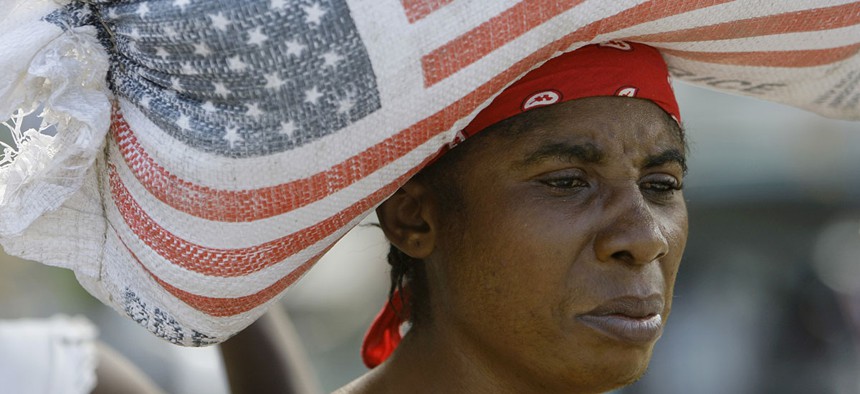This Aid Agency Is Using Chatbots to Beat World Hunger

a woman carries a bag containing rice donated by the United States Agency for International Development. Lynne Sladky/AP File Photo
Turning smartphones and social media into lifelines for the most vulnerable of refugees.
Smartphones and chatbots have made services from banking to transportation more accessible across Africa. Now, aid agencies are hoping they can do the same with food.
The U.N.’s World Food Program (WFP), has been experimenting with text and Facebook messenger chatbots to monitor food insecurity in hard-to-reach areas, turning smartphones and social media into lifelines for the most vulnerable of refugees.
WFP first began to assess food needs using text messages and interactive voice response systems in Somalia and the Democratic Republic of Congo in 2014, with help from global information and audience measurement company Nielsen. This year, they expanded to using chatbots on the Facebook messenger platform. Approximately 170 million Africans use Facebook, mostly on their phones.
Traditionally, WFP has assessed which areas are most in need of food using in-person interviews. But the success of the initial chat program prompted WFP to try more interactive bots, because they offered a wider reach that could collect more nuanced data than an SMS. The WFP’s “Food Bot,” rolled out earlier this year, works on apps like Facebook Messenger and Telegram and can be adapted to other platforms. Data collectors have been helped by the availability in developing countries of Facebook Lite, which uses less data, and ‘social bundles’ from operators which offer cheaper rates for apps like Facebook Lite and WhatsApp.
“How many of you have smartphones?” aid workers asked refugees in northern Nigeria as they considered expanding the project to chatbots. “We waited for the question to be asked in Hausa, and out came mobile devices of all shapes and sizes.”
“‘How many of you have Facebook accounts?’ Even before the question was translated, we saw nods all around,” WFP said in a recent blog post detailing the results of its “mobile vulnerability analysis mapping” experiment.
A huge advantage of the 2014 pilot texting program is that it allowed WFP to access unsafe areas in the DRC and Somalia while also overcoming language barriers. As a result, the program was extended to Guinea, Liberia, and Sierra Leone. At the time, the Ebola epidemic had ground food production to a halt, leaving thousands vulnerable to starvation. The SMS-driven data collection helped uncover where food insecurity was worst: in rural areas, where already isolated neighborhoods had been completely cut off.
The technology also allowed the WFP to conduct research more frequently and spot patterns. Women were more likely to report that they were food insecure, their research found, and homes where women were the head of the household were more vulnerable to hunger.
Collecting data using mobile phones also saved the WFP more than 50 percent of the $200,000 to $300,000 it usually spends on data collection.
WFP has now run the program in 33 different countries including Iraq, according to their blog. Despite its success, and the potential it holds to streamline data collection for already stretched humanitarian agencies, WFP acknowledges that using bots alone isn’t enough. In many cultures, it found, face-to-face interviews led to a higher response rate. A chatbot is also likely to miss important body language and linguistic cues. Still, the combination of human aid workers and bots could get more people the help they need.
Charity organizations elsewhere are using bots to reach more people. Sheldon, the housing shelter charity bot, helps educate homeless people in Scotland on their property rights, connecting them with resources. During the Ebola epidemic in West Africa, hackers developed several chat-based apps to help people find medical assistance or help aid workers identify new danger zones.





